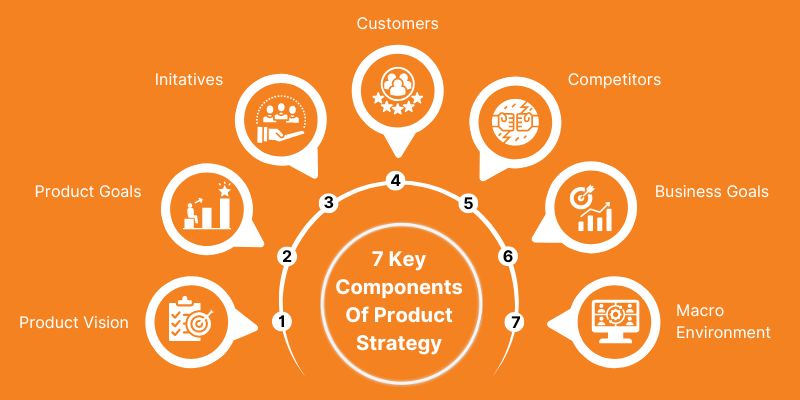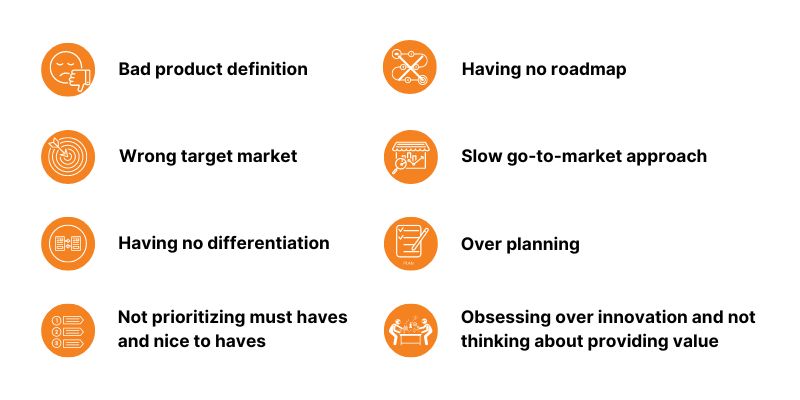Did you know?
48% of software project failures are the result of insufficient documentation. (- Statista)
Yes! Many companies need to improve at simple documentation.
A recent study shows that four out of five new products fail to make a dent in already crowded markets. Therefore, product managers need to avoid mistakes that often result in disappointment. Using cumbersome spreadsheets instead of appropriate planning tools (PMs often waste a lot of time each week) to implement everything but the kitchen sink, product managers seem more likely to make mistakes than to make things right.
So, to save you from this, in this article, we have pointed out some key components of a product strategy and common product strategy mistakes you should be careful to avoid.
A Quick Overview of Product Strategy
Product strategy is a high-level plan that describes what the product is and who it is for. It’s the foundation of all product development because it determines how you build your features, how they work together, and whether they’re even necessary.
Your product strategy should include the following:
- A description of who will use it (e.g., “the people who own cats” or “everyone”)
- An explanation of why someone would want to use your product over other offerings
7 Key Components of Product Strategy

1. Product vision
A software product vision is a statement that describes the desired outcome of a software development project. It provides a clear and concise understanding of the goals and objectives of the project and serves as a guide for the development team throughout the project. A software product vision should be specific, measurable, achievable, relevant, and time-bound, and it should inspire and align the stakeholders in the product development process.
Some examples of a software product vision could be:
- “To create a mobile app that makes it easy for busy people to manage their finances.”
- “To develop a software tool that allows small businesses to analyze their sales data and make informed decisions.”
- “To build a website that connects freelance workers with short-term project opportunities.”
A product vision should communicate the software product’s business value and target user, what problem it aims to solve and how it will create value for the target user. It should be easily understood by everyone involved in the project, including developers, stakeholders, and users.
2. Product goals
Software product goals are the specific objectives that a software development project aims to achieve. They are closely tied to the overall product vision and provide a more detailed and measurable understanding of what the project team is trying to accomplish.
Some examples of software product goals include:
- Increase user engagement on the app by 15% within the first quarter after the launch
- Reduce the time it takes for small business owners to analyze their sales data by 50%
- Improve the website’s matching algorithm to reduce the average time freelancers spend searching for project opportunities by 25%
Product goals should be specific, measurable, and achievable. Setting clear and measurable goals allows the development team to track progress, measure success, and make data-driven decisions. Goals should align with the product vision, and each goal should have specific metrics associated with it that can be used to track progress and measure success.
[Also Read: 6 Ways For Product Development and Launch Successfully]
3. Initiatives
A software product initiative is a specific action or set of steps to achieve one or more software product goals. It is a focused effort to deliver new features, improvements, or enhancements to a software product to achieve the product vision and strategy goals. Initiatives are often used to achieve specific objectives or to address specific pain points in the product.
Some examples of software product initiatives include:
- Introduce a new feature that allows users to set personal financial goals and track their progress
- Re-architect the product’s data analytics module to improve performance and scalability
- Create a mobile-responsive design to improve the user experience on mobile devices
4. Customers
Engaging with customers early and regularly throughout the development process is important to gather feedback, validate assumptions, and ensure that the product meets their needs. This can be done by involving them in product development, testing, and acceptance processes.
Understanding the needs and requirements of customers is a crucial aspect of software development, as it helps to ensure that the product meets their needs and solves the problem it was designed to address.
There are different types of customers in software development, each with unique needs and requirements. For example, some common types of customers in software development include:
- Internal customers: These are customers within the same organization as the development team, such as other departments or business units.
- External customers are customers outside the organization, such as individuals or businesses using the software product.
- Power users: These are customers who are highly proficient in using the software and have specific needs or requirements.
- Casual users: These customers will use the software infrequently and may need more experience.
5. Competitors
Analyzing competitors can help identify opportunities and areas for improvement in the product and understand what works well in the market and what customers are looking for. This can be done by researching and analyzing their products, marketing strategies, pricing, and customer feedback.
There are different types of software development competitors, each with unique strengths and weaknesses. Some common types of competitors include:
- Direct competitors: These are companies or organizations that offer a similar product or service to the one being developed.
- Indirect competitors: These are companies or organizations that offer a different product or service that can be used to solve the same problem or meet the same need as the one being developed.
- Substitute products or services: These are alternative solutions that could replace the product or service being developed.
6. Business Goals
Software business goals are the specific objectives that a software development company or organization aims to achieve. These goals may be related to revenue, market share, customer satisfaction, or other business-related metrics. They provide a more detailed and measurable understanding of what the organization is trying to accomplish and align with the overall business strategy.
Some examples of software business goals include:
- Increase annual revenue by 20% in the next financial year
- Achieve a market share of 15% in the enterprise software market
- Increase customer satisfaction ratings from current customers by 10% in the next quarter
- Reduce development costs by 15% in the next financial year
7. Macro environment
The macro-environment refers to the external factors and conditions that affect a company or organization’s ability to operate and compete in the marketplace. These factors include economic, technological, political, cultural, and social aspects. These can significantly impact a company’s strategy and operations. Understanding the macro environment is essential for a company to identify opportunities and threats and to make informed decisions.
Understanding the macro environment can help a company make informed decisions about its strategy and operations. This can be done through research and analysis of various data, such as economic reports, market trends, and social media data. By understanding the macro environment, a company can identify potential threats and opportunities and adjust its business strategy and operations accordingly.
8 Product Strategy Mistakes You Must Avoid

1. Bad product definition
If you need to figure out who your customers are, it’s time to get some clarity. You need a clear understanding of what problem you’re solving for them.
Make sure the problem you are solving is accurate and relevant. Don’t try to solve too many problems at once—focus on one thing and work from there.
Avoid trying to solve a problem that doesn’t exist or has been solved already (e.g., “I want my company’s website to be better”). This will only lead down a blind alley; your competitors have already done this research and come up with something better than what you could ever come up with!
2. Wrong target market
It is essential to target your product in the right market. This means that you need to define your target audience and their needs. If you are creating a software product for children, it will make no sense for them to be able to access it from their mobile phones if they live in rural India or Saudi Arabia. The same goes for adults: if they cannot afford the monthly bill required by most smartphones, they should not be able to use an app on these devices!
To determine what kind of people fall into each category (e.g., families vs. singles), try answering some questions such as:
“What do my customers want?” “How much money do they have in their pockets?” “Who are they closest friends with?”
These questions will help shape just how significant each segment might be within your community – allowing us to know precisely where we should focus our efforts next time.:
3. Having No differentiation
To differentiate your product, you must be able to identify and define the key components of your offering. You should also know how those components come together in an overall offering that provides value for customers.
So, let’s start with differentiation: why it matters, what types of products are commonly differentiated by their software development process (or lack thereof), and how you can do it yourself!
4. Slow go-to-market approach
Slow go-to-market is a mistake because it takes too long to get your product to market.
If you are an early-stage startup, don’t wait until you have everything perfect before starting the product development lifecycle. Don’t wait until all your funding has been secured and all team members are ready. You should be able to start developing your MVP as soon as possible because if not, then there will always be that one thing that needs fixing or reworking, and this will affect how many features can be included in each version.
5. Having No roadmap
You have to define the problem before you can solve it.
Set realistic and concrete goals but ambitious enough to spark motivation.
Don’t worry about other people’s goals—you’re the expert in your field! Just make sure they fit with yours, and don’t feel like an imposter if you’re setting high-level ambitions for yourself.
[Also Read: Product Roadmap Mistakes You Need to Avoid]
6. Obsessing over innovation and not thinking about providing value
If you’re obsessed with the next big thing, you’ll lose sight of how your product can help people achieve their goals. For example, if you’re building a tool that helps salespeople track leads and contacts, you must ask yourself: Why are these people using our tool in the first place? What problems do they want us to solve for them? You might come up with an innovative idea—but if no one needs it and nobody cares about it, what’s the point?
Your company should be focused on solving real problems for customers (and not just building “the next big thing”), so they’ll keep coming back for more. Think about how your product will help them achieve their goals—not just what features or functions it offers—and then figure out how those benefits translate into value for customers’ lives outside of work hours!
7. Not prioritizing must haves and nice to haves.
A key component of creating a product strategy is having a proper idea of what features must have and what are nice-to-haves.
Must haves: These are features that are required to make the product successful and, therefore, should be prioritized.
Nice to haves: These are features that you might want or need in the future but can be put on hold until they become more necessary.
Look at the app’s features, then decide what can be added without overburdening it.
8. Over planning
Over-planning is when you create a plan for your product that’s too detailed or goes beyond what’s necessary to complete your goal.
If you’ve ever had to write a 10-page business plan, then you know what I’m talking about. Overplanning can prevent you from being realistic about how much time and money will be needed to develop the product or service. This can lead to frustration and burnout among team members who feel they need more control over their workloads or timelines.
Wrapping Up
It is easy to make mistakes when building software products from scratch. From communication holes to overlooked bugs, everything can affect your development procedure. It is essential to be aware of these mistakes to avoid or overcome them effectively. The best way to manage your project is to either build your team or hire a product development expert. When it comes to building your product with minimal risk, the latter option would be a better choice. Get in touch with a professional product development company for your business success.
Supercharge your product strategy with expert developers
Request Free Consultation
Summary
Kickstart Your Project With Us!
Popular Posts
CONTACT US
Let's Build Your Agile Team.
Experience Netsmartz for 40 hours - No Cost, No Obligation.
Connect With Us Today!
Please fill out the form or send us an email to







